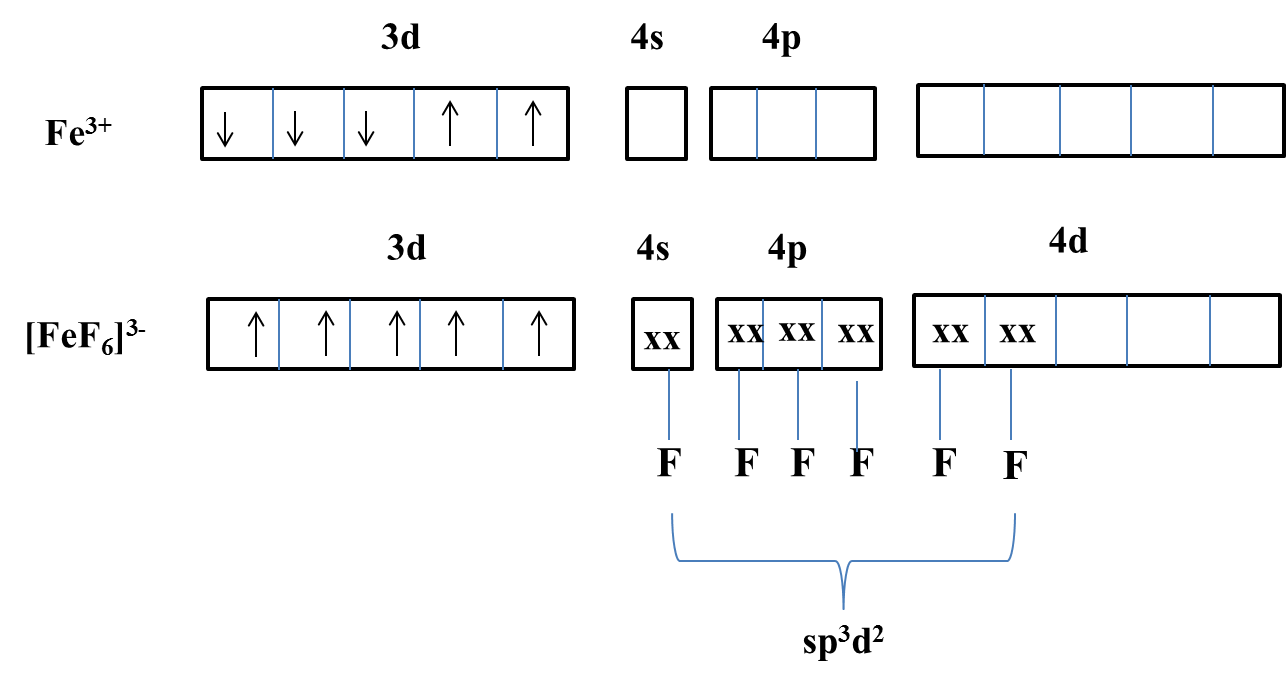
${{[Fe{{F}_{6}}]}^{3-}}$ has Fe atom _________hybridized with unpaired_______electrons.
(A) ${{d}^{2}}s{{p}^{3}}$ , 4
(B) ${{d}^{2}}s{{p}^{3}}$ , 5
(C) $s{{p}^{3}}{{d}^{2}}$, 5
(D) $s{{p}^{3}}{{d}^{2}}$, 3
Answer
483.6k+ views
Hint: The hybridization of the inorganic complexes is going to depend on the type of ligand. If the ligand is a strong ligand then the inner orbital complex is going to form and if the ligand is weak then the outer orbital complex is going to form.
Complete step by step solution:
-In ${{[Fe{{F}_{6}}]}^{3-}}$ one iron atom and six fluorine atoms are there.
-We know that fluorine is a weak ligand and forms an outer orbital complex with iron.
-The oxidation state of iron in ${{[Fe{{F}_{6}}]}^{3-}}$ is as follows.
x + 6(-1) = -3
x – 6 = -3
x = 3
Here x = oxidation state of iron
-The electronic configuration of iron is as follows.
\[1{{s}^{2}}2{{s}^{2}}2{{p}^{6}}3{{s}^{2}}3{{p}^{6}}4{{s}^{2}}3{{d}^{6}}4{{p}^{0}}4{{d}^{0}}\]
-The electronic configuration of iron in ${{[Fe{{F}_{6}}]}^{3-}}$ is as follows.
\[1{{s}^{2}}2{{s}^{2}}2{{p}^{6}}3{{s}^{2}}3{{p}^{6}}4{{s}^{0}}3{{d}^{5}}4{{p}^{0}}4{{d}^{0}}\]
-Six fluorine atoms donate electrons to iron.
-The hybridization of Fe atom in ${{[Fe{{F}_{6}}]}^{3-}}$ is as follows.

-From the above picture we can say that iron undergoes $s{{p}^{3}}{{d}^{2}}$ hybridization.
-From the above picture, we can also say that iron in ${{[Fe{{F}_{6}}]}^{3-}}$ have 5 unpaired electrons.
-Therefore the hybridization of iron in ${{[Fe{{F}_{6}}]}^{3-}}$ is $s{{p}^{3}}{{d}^{2}}$ with 5 unpaired electrons.
So, the correct option is (C).
Note: An inorganic metal complex in which the central metal atom utilizes outer d orbitals for hybridization then the complex is called outer orbital complex. An inorganic metal complex in which the central metal atom utilizes inner d orbitals for hybridization then the complex is called inner orbital complex.
Complete step by step solution:
-In ${{[Fe{{F}_{6}}]}^{3-}}$ one iron atom and six fluorine atoms are there.
-We know that fluorine is a weak ligand and forms an outer orbital complex with iron.
-The oxidation state of iron in ${{[Fe{{F}_{6}}]}^{3-}}$ is as follows.
x + 6(-1) = -3
x – 6 = -3
x = 3
Here x = oxidation state of iron
-The electronic configuration of iron is as follows.
\[1{{s}^{2}}2{{s}^{2}}2{{p}^{6}}3{{s}^{2}}3{{p}^{6}}4{{s}^{2}}3{{d}^{6}}4{{p}^{0}}4{{d}^{0}}\]
-The electronic configuration of iron in ${{[Fe{{F}_{6}}]}^{3-}}$ is as follows.
\[1{{s}^{2}}2{{s}^{2}}2{{p}^{6}}3{{s}^{2}}3{{p}^{6}}4{{s}^{0}}3{{d}^{5}}4{{p}^{0}}4{{d}^{0}}\]
-Six fluorine atoms donate electrons to iron.
-The hybridization of Fe atom in ${{[Fe{{F}_{6}}]}^{3-}}$ is as follows.

-From the above picture we can say that iron undergoes $s{{p}^{3}}{{d}^{2}}$ hybridization.
-From the above picture, we can also say that iron in ${{[Fe{{F}_{6}}]}^{3-}}$ have 5 unpaired electrons.
-Therefore the hybridization of iron in ${{[Fe{{F}_{6}}]}^{3-}}$ is $s{{p}^{3}}{{d}^{2}}$ with 5 unpaired electrons.
So, the correct option is (C).
Note: An inorganic metal complex in which the central metal atom utilizes outer d orbitals for hybridization then the complex is called outer orbital complex. An inorganic metal complex in which the central metal atom utilizes inner d orbitals for hybridization then the complex is called inner orbital complex.
Recently Updated Pages
The correct geometry and hybridization for XeF4 are class 11 chemistry CBSE

Water softening by Clarks process uses ACalcium bicarbonate class 11 chemistry CBSE

With reference to graphite and diamond which of the class 11 chemistry CBSE

A certain household has consumed 250 units of energy class 11 physics CBSE

The lightest metal known is A beryllium B lithium C class 11 chemistry CBSE

What is the formula mass of the iodine molecule class 11 chemistry CBSE

Trending doubts
Why was the Vernacular Press Act passed by British class 11 social science CBSE

Arrange Water ethanol and phenol in increasing order class 11 chemistry CBSE

Name the nuclear plant located in Uttar Pradesh class 11 social science CBSE

One Metric ton is equal to kg A 10000 B 1000 C 100 class 11 physics CBSE

What steps did the French revolutionaries take to create class 11 social science CBSE

How did silk routes link the world Explain with three class 11 social science CBSE




